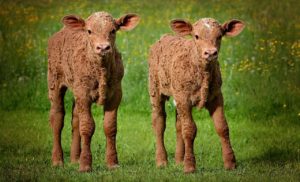Lungworm Vaccination
1 February 2017 Outbreaks of lungworm are not uncommon in cattle. They usually occur between July and September, but this season can be longer, depending on the weather.
Outbreaks of lungworm are not uncommon in cattle. They usually occur between July and September, but this season can be longer, depending on the weather.
Cost
Costs of lungworm outbreaks are estimated at £50-100 per head, and can be higher if it is not caught early, and calves are lost. While traditionally this was a condition seen in first grazing season animals, we are increasingly seeing lungworm in older animals, including adult cattle.
In dairy cows, this may be because youngstock are being housed, and so animals may be grazed for the first time as milking heifers. However, we also see this in beef animals. Lungworm will not necessarily be present on every field, every year and so exposure will vary. Animals build up immunity in response to exposure to lungworm, and if this does not occur, they remain susceptible.
Because lungworm is unpredictable grazing management cannot be used to prevent exposure to this parasite.
Treatment
While anthelmintic treatment is effective at killing lungworm, the time of year at which lungworm strikes can be variable and is difficult to predict. By the time animals are seen to be coughing, there will already be lung damage, which can result in secondary bacterial infections and long-lasting implications for the animal and the herd. Some animals infected with lungworm will remain stunted, or will never fully recover from the lung damage.
Depending on anthelmintic treatments given first grazing season calves may be protected, or treated before infection has a chance to build up. However, if calves are at grass well into the autumn they may be exposed at this time.
Herds which have had problems with lungworm in the past, or have neighbours who have experienced outbreaks should consider a vaccination protocol.
If gut worms are managed in first grazing season calves by grazing management, or monitoring of faecal egg counts, then vaccination should be considered in these animals. For late spring-born calves, it may not be possible to complete the full course of vaccination prior to turnout.
If the anthelmintic treatment given is considered to be protective during the first grazing season, then consider vaccinating prior to the second grazing season. This will help heifer replacements to become immune and reduce the likelihood of them being affected as adult animals. This is preferable to continuing anthelmintic treatment into the second grazing season.
Animals can be vaccinated when they are eight weeks of age or older. Two oral doses of vaccine four weeks apart are needed, and animals will be immune two weeks after the second dose. Anthelmintic treatment cannot be used until 2 weeks after the second dose of vaccine, as the vaccine contains live irradiated lungworm larvae.
Continued immunity to lungworm from this single primary course needs to be boosted by natural exposure. If animals are on clean grazing for a large part of the grazing season, then a single booster before turnout each year may be beneficial. Discuss the best vaccination schedule with your vet.
For more information, please see the COWS website at www.cattleparasites.org.uk.
If cattle are being treated prior to housing with a persistent product, then it is ideal to treat two weeks before housing. This may tie in with administration of pneumonia vaccine if this is being used. Dosing at this time avoids the stress of housing coinciding with the animals being treated, as lung damage and clearing dead worms from the lung tissue can contribute to pneumonia risk.
Katrina Henderson,katrina.henderson@sac.co.uk
Sign up to the FAS newsletter
Receive updates on news, events and publications from Scotland’s Farm Advisory Service
